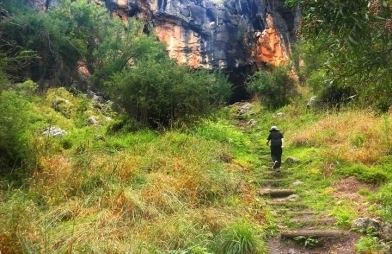Lighting Nil | Area 136 ha | |
 | ||
Discovery 9,000 years ago – Wiradjuri1830 – John Henderson Access Public; limited access May–October Features Home to Eastern bent-winged bats Management National Parks and Wildlife Service Similar Gamilaroi Nature Reserve, Bird Island Nature Reserve, Gumbaynggirr State Conserva, Yatteyattah Nature Reserve, Davis Scrub Nature R | ||
Borenore caves
The Borenore Caves, contained within the Borenore Karst Conservation Reserve, are a series of limestone caves that are located in the Central West region of New South Wales, Australia. The caves are renowned for their karst qualities, namely the numerous fossils from a long-lived reef complex from the Silurian era. Fossils include corals, crinoids, brachiopods, gastropods, pentamerids, colonial tryplasmids and trilobites. Borenore's karst is totally surrounded by igneous rock that flowed from volcanic eruptions at nearby Mount Canobolas.
Contents
- Borenore caves
- Map of Borenore Caves Borenore NSW 2800 Australia
- Borenore caves 2013
- Features and location
- Mining
- References
Map of Borenore Caves, Borenore NSW 2800, Australia
The 136-hectare (340-acre) reserve is situated 17 kilometres (11 mi) west of Orange, and is registered as a natural heritage site on the Register of the National Estate for its large diversity of karst morphological and sedimentological features. Camping in the reserve is not permitted.
Borenore caves 2013
Features and location
Access is self-guided and suitable for casual visitors. Entry to the reserve is free.
The reserve contains over forty caves, including:
Mining
The caves are also notable as a source of Borenore Red marble early in the twentieth century, which was mined in the area until 1994. Borenore Red marble may be found in The Strand Arcade and in Buckingham Palace. Around 1898, while enjoying a picnic at Borenore, Frank Rusconi, a monumental stonemason from Italy, recognised the rich quality of the marble on the reserve. This marble was considered to be some of the best in the world and was mined for around thirty years. An example of the famous Borenore red marble can be seen in Jenolan Caves House as a mantle piece.
